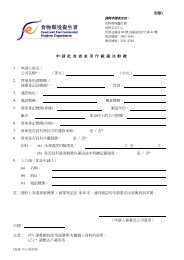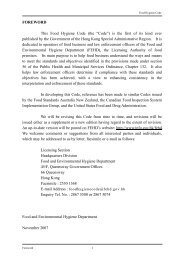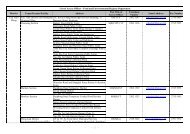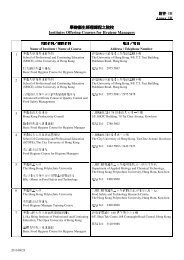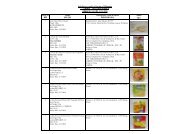Anti-mosquito Measures - Advice for Hospitals / Clinics
Anti-mosquito Measures - Advice for Hospitals / Clinics
Anti-mosquito Measures - Advice for Hospitals / Clinics
Create successful ePaper yourself
Turn your PDF publications into a flip-book with our unique Google optimized e-Paper software.
<strong>Advice</strong> <strong>for</strong> hospitals/clinics<br />
<strong>Anti</strong>-<strong>mosquito</strong> measures<br />
Purpose<br />
The in<strong>for</strong>mation provided below is to help the management of hospitals/clinics in<br />
preventing and controlling the breeding of <strong>mosquito</strong>es – Aedes albopictus.<br />
Mosquito problems<br />
2. Mosquitoes cause great nuisance to man. Moreover, some of the species pose threats<br />
to human health as vectors of diseases like dengue fever. Dengue fever is a severe<br />
<strong>mosquito</strong>-borne disease characterised by high fever, headache, rash, joint and<br />
muscular pain. Aedes albopictus, which is a vector of dengue fever and dengue<br />
haemorrhagic fever, is prevalent locally. They breed in rural and urban areas and<br />
their breeding sites can be grouped generally into two categories: the artificial<br />
receptacles like containers, discarded tyres, lunch boxes, cans, clogged surface<br />
channels; and naturally occurring habitats, e.g. tree holes, bamboo stumps and leaf<br />
axils.<br />
<strong>Anti</strong>-<strong>mosquito</strong> programme<br />
3. To control and prevent <strong>mosquito</strong> problems in general and spread of dengue fever in<br />
hospitals/clinics, carefully planned anti-<strong>mosquito</strong> programme is needed <strong>for</strong> each<br />
individual hospital. As participation is important <strong>for</strong> the success of the programme,<br />
staff of hospitals are encouraged to take part in the <strong>mosquito</strong> control.<br />
Objectives<br />
4. The anti-<strong>mosquito</strong> programme aims to achieve the following objectivesi)<br />
To encourage staff of hospitals/clinics to participate in preventing and controlling<br />
<strong>mosquito</strong> breeding in hospitals;<br />
ii) To eliminate breeding sites <strong>for</strong> <strong>mosquito</strong>es especially containers; and<br />
iii) To arouse and maintain the awareness of staff of hospitals/clinics on the potential<br />
risk of dengue fever transmission.<br />
Target areas<br />
5. The whole hospital/clinic building/compound should be the target area of the<br />
programme.<br />
1
Working schedule<br />
6. As it takes an average of 7 days <strong>for</strong> eggs of <strong>mosquito</strong>es to develop<br />
into adult <strong>mosquito</strong>es, the inspection cycle should be a 7-day cycle.<br />
Programme coordination<br />
7. A staff of the management of the hospital/clinic should be designated as<br />
the coordinator <strong>for</strong> implementation of the programme and liaison with staff of the<br />
Food and Environmental Hygiene Department.<br />
Mosquito control measures<br />
8. Some of the commonly found potential breeding places <strong>for</strong> <strong>mosquito</strong>es in<br />
hospitals/clinic buildings/compounds and the ways of elimination are given in the<br />
tables below:<br />
i) Aesthetic problems<br />
Breeding place Cause of problem Control action Remark<br />
Tree holes and<br />
bamboo stumps<br />
Leaf axils of plant<br />
Saucers <strong>for</strong><br />
ornamental potted<br />
plants<br />
Natural water<br />
receptacles.<br />
Natural water<br />
receptacles.<br />
Excessive watering<br />
causes<br />
accumulation of<br />
water in saucers.<br />
Fill with sand, mud<br />
or concrete as<br />
appropriate.<br />
Remove water<br />
accumulated.<br />
Drain away water<br />
immediately after<br />
watering.<br />
Plants with small<br />
leaves or small<br />
leaf axils should<br />
be grown.<br />
Avoid using<br />
saucers <strong>for</strong> potted<br />
plants.<br />
Flower vases<br />
Water kept in<br />
vases provide<br />
breeding places <strong>for</strong><br />
<strong>mosquito</strong>es.<br />
Water in vases<br />
should be changed<br />
at least weekly.<br />
2
ii) Structural problems<br />
Breeding place Cause of problem Control action Remark<br />
Roof gutters and<br />
surface drainage<br />
channels<br />
Uneven floor<br />
Sand traps, gully<br />
traps and drain<br />
holes<br />
iii) Hygienic problem<br />
Breeding place Cause of problem Control action Remark<br />
Junk<br />
Discarded bottles,<br />
cans and empty<br />
lunch boxes<br />
Rubbish<br />
1. Structurally<br />
deficient roof<br />
gutters and<br />
surface drainage<br />
channels hold<br />
water readily.<br />
2. Choked with<br />
refuse or leaves.<br />
Collect water<br />
during scrubbing of<br />
floor or rain water<br />
if the floor is open.<br />
The design and<br />
choking of the<br />
traps/holes causes<br />
collection of water.<br />
Rain water and<br />
water from<br />
cleansing of floor<br />
trapped by junk.<br />
Collect rainwater<br />
readily.<br />
Trapping water.<br />
1. They should be<br />
repaired.<br />
2. Clear leaves and<br />
debris regularly,<br />
at least weekly.<br />
Regular sweeping,<br />
at least weekly, is<br />
required <strong>for</strong><br />
removing the<br />
water until<br />
structural<br />
improvement has<br />
been made.<br />
1. Clear refuse and<br />
debris at least<br />
weekly.<br />
2. Apply<br />
larvicide to<br />
water.<br />
Keep in junk<br />
collection areas<br />
with cover.<br />
Keep in containers<br />
with well-fitted<br />
cover.<br />
Keep in disposable<br />
plastic bags which<br />
should then be tied<br />
up at the openings<br />
and kept in<br />
containers with<br />
cover.<br />
Scrubbing junk<br />
collection areas<br />
only when the<br />
junk has been<br />
cleared.<br />
3
iv) Other problems<br />
Breeding place Cause of problem Control action Remark<br />
Disused tyres as<br />
anti-bumping<br />
device<br />
Water storage<br />
containers<br />
Rain water and<br />
water from car<br />
washing trapped<br />
by tyres.<br />
Containers placed<br />
outdoors collect<br />
rain water readily.<br />
Puncture with big<br />
holes.<br />
Cover with lid.<br />
Preferably,<br />
anti-bumping<br />
device should be<br />
replaced by<br />
marking on the<br />
floor.<br />
Water storage<br />
should be<br />
replaced by water<br />
pipe with tap.<br />
Water trays of<br />
refrigerators with<br />
automaticdefrosting<br />
and air<br />
conditioner trays<br />
Water may be<br />
accumulated in<br />
trays.<br />
Water in trays<br />
should be removed<br />
weekly or properly<br />
drained away.<br />
They are usually<br />
overlooked during<br />
<strong>mosquito</strong> surveys.<br />
9. In general larviciding must only be carried out if the breeding sources or potential<br />
breeding grounds are inaccessible or could not be eliminated within one week.<br />
Action checklist<br />
10. To enhance the monitoring of the <strong>mosquito</strong> control work, a checklist on the breeding<br />
place <strong>for</strong> <strong>mosquito</strong>es and action taken could be prepared <strong>for</strong> the programme by<br />
making reference to those mentioned in paragraph 8 above.<br />
11. The management of hospital/clinic could appoint a pest control company <strong>for</strong><br />
providing services on <strong>mosquito</strong> control and prevention in the hospital/clinic<br />
building/compound. <strong>Advice</strong> on <strong>mosquito</strong> prevention could be obtained from the<br />
Food and Environmental Hygiene Department.<br />
4



